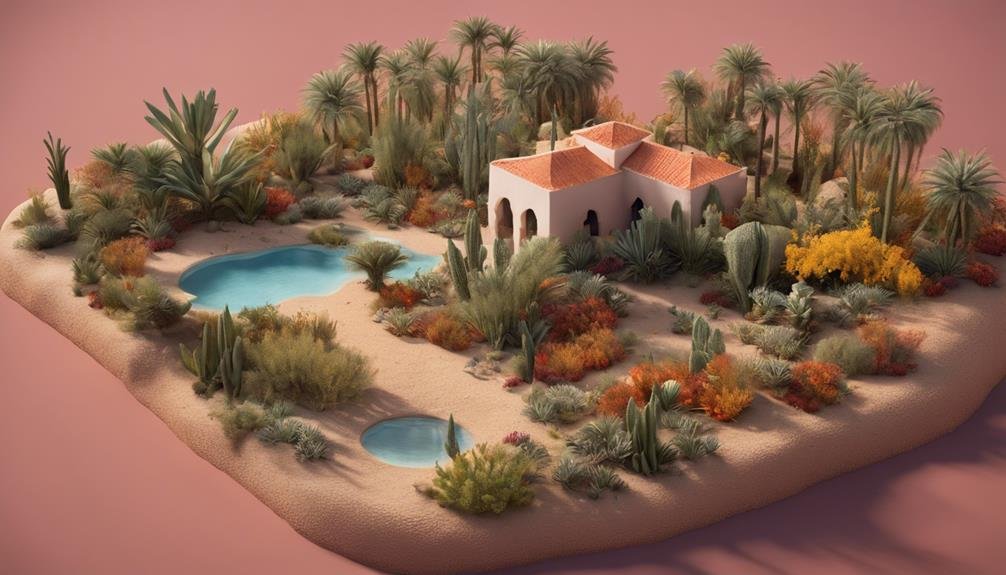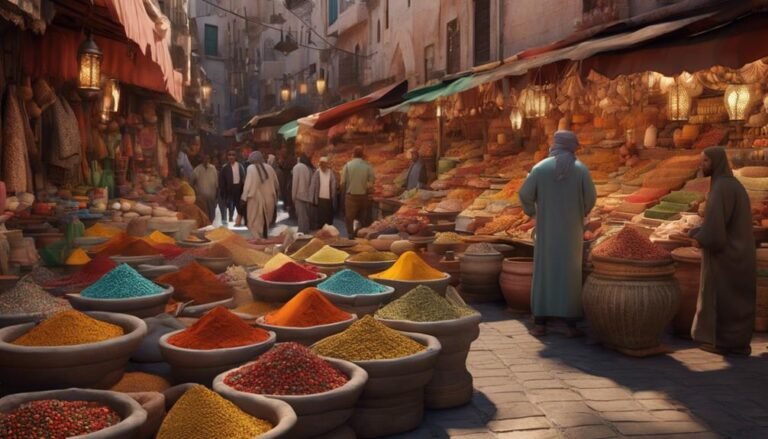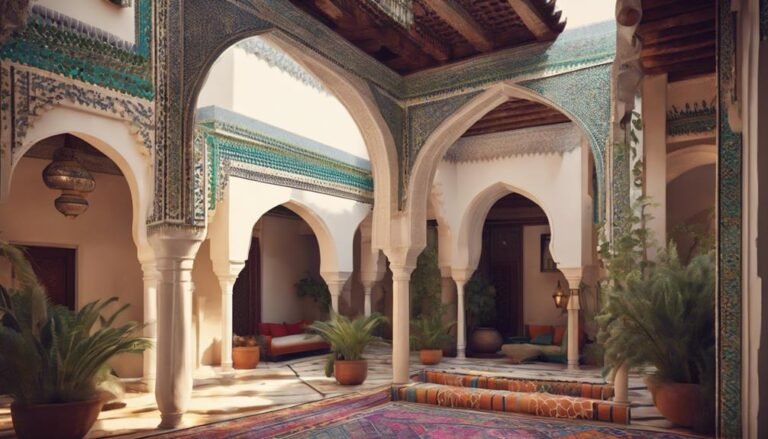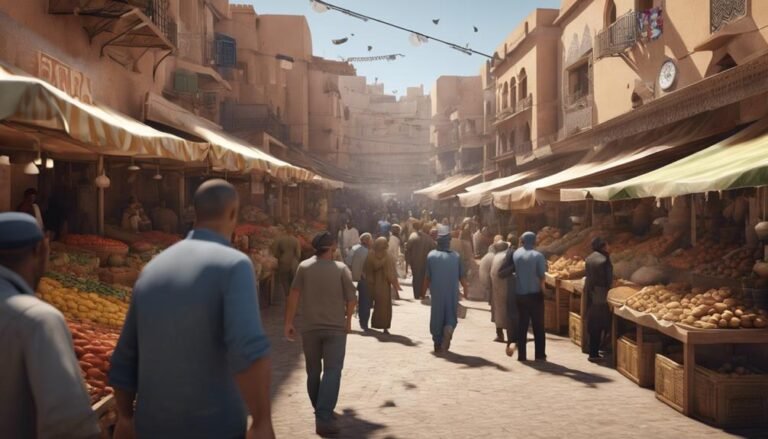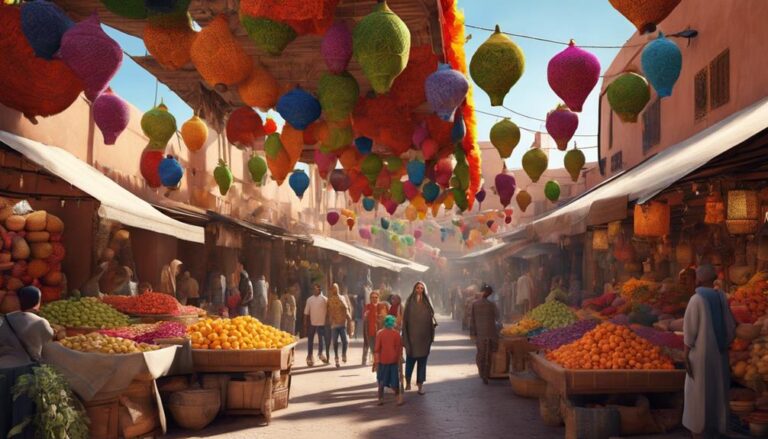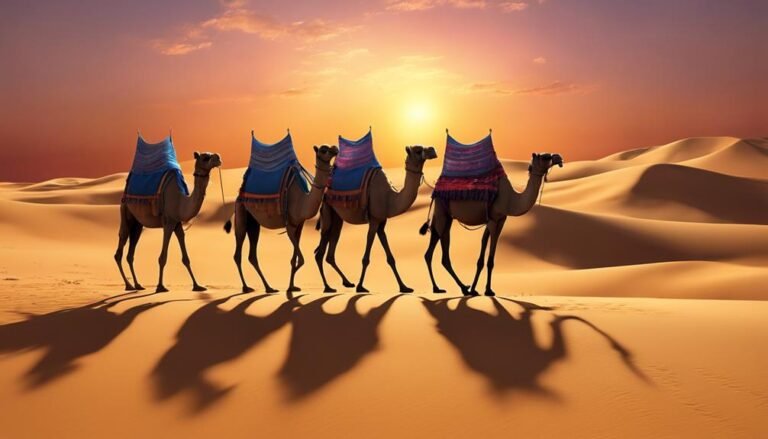Morocco boasts a vast array of flora and fauna, thanks to its diverse geography. From high-altitude mountain species with unique adaptations to desert plants and animals thriving in harsh conditions, each ecosystem showcases remarkable biodiversity. Coastal regions teem with diverse marine life, while wetlands and rivers provide habitats for a wide variety of species. Morocco is home to endemic plants like the critically endangered Argan tree and unique animals like the Barbary macaque. Conservation efforts play an essential role in safeguarding these specialized species and habitats, ensuring a sustainable environment for its rich biodiversity.
Key Takeaways
- Morocco's diverse geography creates varied habitats for a wide range of flora and fauna.
- Unique adaptations are observed in high-altitude plants and alpine fauna.
- Desert ecosystems showcase remarkable adaptations in plants and animals.
- Coastal areas support a rich diversity of marine and terrestrial species.
- Endemic species like the Argan tree and Barbary macaque highlight Morocco's rich biodiversity.
Geographic Diversity
Morocco boasts a rich and varied geographic landscape that plays a significant role in shaping the diversity of flora and fauna found within its borders. The country's diverse climate variations, ranging from Mediterranean in the north to arid Saharan conditions in the south, contribute to the unique species distribution observed across different regions.
Geographic barriers in Morocco, such as the Atlas Mountains and the Sahara Desert, have led to genetic isolation among various plant and animal species. These barriers prevent gene flow between populations, resulting in distinct genetic characteristics within different ecological niches. For example, species adapted to the harsh desert environment display genetic traits that allow them to thrive in arid conditions, showcasing the intricate relationship between geography and genetic diversity.
Understanding how climate variations and geographic barriers influence species distribution and genetic isolation is essential for conserving Morocco's rich biodiversity. By studying these factors, researchers can develop effective conservation strategies to protect the unique flora and fauna that call Morocco home.
Mountainous Habitats
As you ascend the rugged terrains of Morocco's mountainous habitats, you'll encounter a rich array of high-altitude plant species uniquely adapted to the challenging environment. These plants exhibit specialized features like small leaves or deep root systems to withstand the harsh conditions of the elevated landscapes.
Additionally, the alpine fauna of these regions have evolved remarkable adaptations such as thick fur or hibernation strategies to thrive in the cold, rocky terrain.
High-Altitude Plant Species
Nestled within the rugged terrain of the Atlas Mountains are unique plant species that have adapted to thrive in high-altitude environments. These high-altitude plant species exhibit remarkable alpine plant adaptations, showcasing the biodiversity present in Morocco's mountainous regions. Conservation efforts are vital to protect the delicate balance of these ecosystems. Here are three key aspects to take into account:
- Specialized Morphology: High altitude flora often have small, thick leaves to reduce water loss and withstand harsh winds and low temperatures.
- Unique Reproductive Strategies: Some plant species at high altitudes rely on wind pollination due to the scarcity of insects in these environments.
- Endemism: Many high-altitude plant species in Morocco are endemic, meaning they're found nowhere else on Earth, emphasizing the importance of preserving these habitats.
Alpine Animal Adaptations
Adaptations among alpine animals in mountainous habitats include specialized physiological features to cope with extreme cold and limited food resources. In snowy survival conditions, alpine animals like the snow leopard have evolved thick fur coats to retain body heat and large paws that act as snowshoes, enabling them to move easily across deep snow.
Alpine foraging involves animals such as the mountain goat, which has adapted with strong, agile bodies to navigate steep, rocky terrain to access scarce vegetation. Some species practice high altitude hibernation, like the marmot, slowing their metabolism to survive harsh winters.
Mountain climber adaptations are seen in animals like the ibex, equipped with remarkable agility and surefootedness to navigate sheer cliffs and rocky slopes.
Desert Ecosystems
The harsh desert environment in Morocco presents a unique ecosystem characterized by extreme temperatures and scarce water availability. In this arid landscape, life thrives against the odds through remarkable adaptations and strategies.
Here's a closer look at the desert ecosystems in Morocco:
- Desert plant adaptations: Plants in the Moroccan desert have evolved to withstand long periods of drought. They often have deep root systems to access underground water sources, reduced leaf surfaces to minimize water loss through transpiration, and some even store water in their tissues.
- Animal survival: Desert animals have developed various mechanisms to survive in this harsh environment. Some have thick, water-resistant skin to prevent dehydration, while others are nocturnal to avoid the scorching heat during the day. Specialized kidneys enable them to concentrate urine and conserve water efficiently.
- Arid ecosystem dynamics, biodiversity hotspots: Despite the challenging conditions, the Moroccan desert is a biodiversity hotspot with a delicate balance of interdependent species. The interactions between plants, animals, and microorganisms contribute to the unique dynamics of this ecosystem, showcasing the resilience and adaptability of life in the desert.
Coastal Biodiversity
Along the coast of Morocco, a rich tapestry of diverse flora and fauna thrives in the dynamic interface between land and sea. Marine life diversity in Moroccan coastal waters is astounding, with a plethora of species inhabiting the vital ecosystems. From colorful fish like the ornate wrasse to majestic creatures such as the bottlenose dolphin, the marine biodiversity here is a sight to behold. Coastal vegetation plays an essential role in supporting this diverse ecosystem, offering shelter and nutrients to a variety of species.
Seabird populations grace the skies and cliffs along the Moroccan coast, adding another dimension to the biodiversity of the region. Species like the Audouin's gull and the majestic osprey are commonly spotted, contributing to the vibrant coastal ecosystem. Shoreline ecosystems, including tidal pools and rocky shores, provide unique habitats for a multitude of organisms, showcasing the intricate interplay between land and sea in sustaining life along the coast of Morocco.
Wetlands and Rivers
Exploring the intricate network of wetlands and rivers in Morocco reveals a fascinating mosaic of biodiversity and ecological interactions. The wetlands and rivers in Morocco are essential ecosystems that support a wide array of plant and animal species.
Here are some key aspects to ponder:
- Birdwatching spots: Morocco's wetlands and rivers provide excellent habitats for a variety of bird species. Birdwatching enthusiasts can spot species like herons, flamingos, and ducks in these areas, making it a paradise for bird lovers.
- Aquatic life: The water bodies in Morocco teem with diverse aquatic life, including fish, amphibians, and invertebrates. These species play a crucial role in the overall health and balance of the wetland ecosystems.
- Wildlife conservation: Efforts towards wildlife conservation in Morocco often focus on protecting the delicate balance of wetland ecosystems. Conservation initiatives aim to safeguard the habitats of endangered species and ensure the sustainability of these crucial ecosystems for future generations.
Forests and Woodlands
Nestled within the diverse landscape of Morocco, forests and woodlands offer a rich tapestry of flora and fauna awaiting exploration and study. The forest biodiversity in Morocco is significant, hosting a variety of plant species such as cork oak, cedar, and Aleppo pine. These forests provide essential habitats for a range of wildlife species, including Barbary macaques, Atlas deer, and numerous bird species. Conservation efforts are essential to protect these ecosystems and the species that rely on them. Wildlife conservation initiatives aim to safeguard the rich biodiversity present in Moroccan forests and woodlands.
Woodland ecology plays an important role in maintaining the delicate balance of these ecosystems. Understanding the interactions between plants, animals, and the environment is necessary for preserving these habitats. Habitat restoration projects are underway to address deforestation and degradation, ensuring the continued health of Morocco's forests. By focusing on woodland ecology and habitat restoration, Morocco can sustain the diverse flora and fauna that call these forests and woodlands home.
Endemic Species
Endemic species in Morocco represent a unique and specialized group of flora and fauna found exclusively within the country's borders. These species have adapted over time to the specific environmental conditions present in Morocco, making them particularly interesting for scientific study. Here are some key points to take into account:
- Rare Flora: Morocco boasts a variety of endemic plant species, such as the critically endangered Argania spinosa, commonly known as the Argan tree. This tree isn't only important for its ecological value but also for its economic significance in the production of Argan oil.
- Unique Fauna: The Moroccan endemic fauna includes species like the Barbary macaque, the only primate species found in North Africa. These primates are a symbol of the region's biodiversity and face threats due to habitat loss and illegal wildlife trade.
- Species Interactions: Endemic species often have intricate relationships with their environment and other organisms. Understanding these interactions is essential for conservation efforts aimed at preserving Morocco's unique biodiversity.
Conservation Efforts
Given the unique biodiversity of endemic flora and fauna in Morocco, ongoing conservation efforts play a pivotal role in safeguarding these specialized species and their habitats. Wildlife protection initiatives in Morocco are essential for preserving the diverse array of species that call this region home. The country has established protected areas such as national parks and nature reserves to conserve critical habitats and provide safe spaces for wildlife to thrive. These efforts are vital for safeguarding endangered species like the Barbary macaque and the Northern Bald Ibis.
Habitat restoration projects are also underway to revitalize ecosystems that have been impacted by human activities and climate change. By restoring degraded habitats, conservationists aim to create sustainable environments where native plants and animals can flourish. Initiatives to replant native vegetation, control invasive species, and rehabilitate degraded lands are key components of these restoration efforts.
Conclusion
As you explore the diverse flora and fauna of Morocco, you'll be amazed by the unique species that call this country home.
From the rugged mountains to the vast deserts, each habitat offers a glimpse into the rich biodiversity of this region.
Conservation efforts are essential to preserving the endemic species that make Morocco a truly special place.
Stay tuned for more updates on the fascinating wildlife of this diverse country.

The Editorial Team is a passionate group of Morocco enthusiasts dedicated to sharing the beauty, culture, and wonders of this captivating country. With diverse backgrounds and a deep love for travel, we strive to bring you engaging and informative content that inspires your Moroccan adventures. From uncovering hidden gems and sharing local insights to exploring mouthwatering cuisine and showcasing the vibrant lifestyle, our team is committed to providing you with valuable resources and exciting stories that enhance your exploration of Morocco. Join us on this journey as we celebrate the rich heritage and unforgettable experiences that make Morocco truly special.

